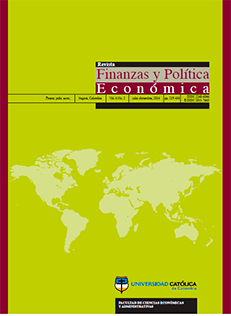This journal is licensed by a Creative Commons Attribution License (CC BY-NC-SA 4.0) Attribution-Non Commercial 4.0 International. For the CC licenses, the principle isthe creative freedom. This system complements the copyright without opposing it, conscious of its importance in our culture. The content of the articles is the responsibility of each author, and does not compromise in any way, to the journal or the university. It allows the transmission and reproduction of titles, abstracts and full content, with academic, scientific, cultural ends, provided acknowledgment of the respective source. This work cannot be used for commercial purposes.
They journal does not charge authors for submission or publication.
Abstract
In recent years, facing the new business environment, the necessity of doing integrated reports has emerged. Companies of the healthcare industry have been pioneers and instigators in their making. For this information to be compared, an International Integrated Reporting Framework (IIRF) has recently been created. In this context, the purpose of this article is to provide evidence of the existent gap between the contents to be included according to such framework and the one writers of the current integrated reports in the healthcare industry understand. In order to achieve this, information included on these reports was analyzed and compared with the IIRF’s suggestions. Results show the existent gap up until now in this industry and the need to continue working on this field.

References
Asociación Española de Contabilidad y Administración de Empresas (AECA). (2011a). Hacia la información integrada. La comunicación de valor en el siglo XXI. Recuperado de http://www.aeca.es/comisiones/rsc/iirc_traduccion_espanol.pdf
Asociación Española de Contabilidad y Administración de Empresas (AECA). (2011b). Información integrada: el cuadro integrado de indicadores (CII-FESG) y su taxonomía XBRL (Documento AECA, 8). Madrid: Responsabilidad Social Corporativa.
Chen, L., Srinidhi, B. & Tsang A., Yu W. (2012). Corporate social responsibility, audit fees and audit opinions, working paper. Virginia: George Mason University.
Deloitte. (2012). Integrated reporting. Navigating your way to a truly integrated reporting. Recuperado de http://www.deloitte.com/assets/Dcom-SouthAfrica/Local%20Assets/Documents/Integrated%20Reporting%20Publication%20II%20(electronic2).pdf
Dey, C. & Burns, J. (2010). Integrated reporting at Novo Nordisk. In accounting for sustainability. En A. Hopwood, J. Unerman & J. Fries (Eds.), Practical insights (pp. 197-214). London: Earthscan.
Eccles, R. G. & Armbrester, K. (2011). Integrated reporting in the cloud. IESE Insight, 8, 13-20.
Eccles, R. G. & King, M. E. (2010). Integrated reports voluntary filing. Focus, 5, 3-6.
Eccles, R. G. & Krzus, M. P. (2010). One report. Integrated reporting for a sustainable strategy. Hoboken: John Wiley and Sons.
Eccles, R. G. & Serafeim, G. (2011). Accelerating the adoption of integrated reporting. En F. Leo & M. Vollbracht (Eds.), CSR Index 2011. Recuperado de http://ssrn.com/abstract=1910965
Fifka, M. S. & Drabble, M. (2012). Focus and standardization of sustainability reporting ?a comparative study of the United Kingdom and Finland. Business Strategy and the Environment, 21(7), 455-475.
Frías-Aceituno, J. V., Rodríguez-Ariza, L. & García-Sánchez, I. M. (2013). The role of the board in the dissemination of integrated corporate social reporting. Corporate Social Responsibility and Environmental Management, 20(4), 219-233.
Frías-Aceituno, J. V., Rodríguez-Ariza, L. & García-Sánchez, I. M. (2014). Explanatory factors of integrated sustainability and financial reporting. Business Strategy and the Environment, 23, 56-72.
González Goraieb, G. C. (2005). Sistema de patentes en farmacéuticos (Tesis profesional). Universidad de lasAméricas, Puebla. Recuperado de http://catarina.udlap.mx/u_dl_a/tales/documentos/ledi/gonzalez_g_gd/
Herzlinger, R. E. (2006). Why innovation in health care is so hard. Recuperado el 20 de enero de 2014 de http://hbr.org/web/extras/insight-center/health-care/why-innovation-in-health-care-is-so-hard
International Integrated Reporting Council (IIRC). (2013). The international framework. Recuperado de http://www.theiirc.org/wp-content/uploads/2013/12/13-12-08-THE-INTERNATIONAL-IR-FRAMEWORK-2-1.pdf
Jensen, J. C. & Berg, N. (2012). Determinants of traditional sustainability reporting versus integrated reporting. An institutionalist approach. Business Strategy and Environment, 21, 299-316.
KPMG. (2010). Información integrada. Completando el ciclo estratégico. Recuperado de http://www.kpmg.com/ES/es/ActualidadyNovedades/ArticulosyPublicaciones/Documents/Informacion-integrada-completandociclo-estrategico.pdf
KPMG. (2012). ¿Refleja su informe anual la capacidad de crear valor de su empresa? Recuperado de http://www.kpmg.com/es/es/servicios/advisory/riskcompliance/iarcs/globalsustainabilityservices/documents/integrated-reporting-service%20sheet.pdf
Lizcano, J. L., Flores Muñoz, F. & Rejón López, M. (2011). El informe integrado: primeras aproximaciones de aplicación. El caso español. Recuperado de http://www.aeca.es/comisiones/rsc/estudio_empirico.pdf
Lozano, R. & Huisingh, D. (2011). Inter-linking issues and dimensions in sustainability reporting. Journal of Cleaner Production, 19, 99-107.
Melé, D. (2006). Las cinco mayores compañías farmacéuticas: imagen corporativa y críticas en responsabilidad social. Cátedra Economía y ÿtica. Recuperado de http://www.iese.edu/research/pdfs/OP-06-05.pdf
PwC. (2012). 12 reporting tips: What does your reporting say about you? Recuperado de https://www.pwc.com/gx/en/corporate-reporting/corporate-reporting-guidelines/assets/pwc-12-reporting-tips.pdf
Saxton, G. D. & Guo, C. (2011). Accountability online: Understanding the web-based accountability practices of nonprofit organizations. Nonprofit and Voluntary Sector Quarterly, 40(2), 270-295.
Sierra-García, L., Zorio-Grima, A. & García-Benau, M. A. (2013). Stakeholder engagement, corporate social responsibility and integrated reporting: An exploratory study. Corporate Social Responsibility and Environmental Management. doi: 10.1002/csr.1345
Smith, J., Haniffa, R. & Fairbrass J. (2010). A conceptual framework for investigating ?Capture? in corporate sustainability reporting assurance. Journal of Business Ethics, 99, 425-439.
Verbruggen, S., Christiaens, J. & Milis, K. (2011). Can resource dependence and coercive isomorphism explain nonprofit organizations? compliance with reporting standards? Nonprofit and Voluntary Sector Quarterly, 40(1), 5-32.
Vives, A. (2013). El informe integrado: lo que podría haber sido y lo que debería ser. Recuperado el 15 de enero de 2014 de http://www.diarioresponsable.com/portada/opinion/16439-el-informe-integrado-lo-que-podriahaber-sido-y-lo-que-deberia-ser.html
Willis, A. (2010). Integrated reporting in a disconnected world? The macro measurement challenge. En R. G Eccles, B. Cheng & D. Saltzman (Eds.), The landscape of integrated reporting. Reflections and next stops (pp. 22-24). Massachusetts: Harvard Business School.





























